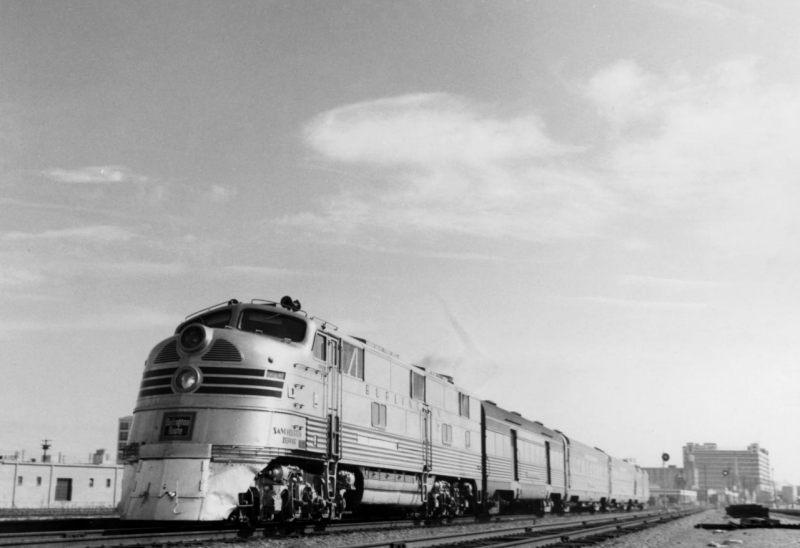Fort Worth and Denver Railway's "Sam Houston Zephyr" train No. 3, southbound, enroute out of Dallas to Houston. Hotel Dallas is in the background. (University of North Texas Libraries, The Portal to Texas History, https://texashistory.unt.edu; crediting Museum of the American Railroad.)

SAM HOUSTON ZEPHYR
The Sam Houston Zephyr was a named passenger train operated by the Burlington-Rock Island Railroad, a subsidiary of both the Chicago, Burlington and Quincy Railroad and the Chicago, Rock Island and Pacific Railroad, and also the Fort Worth and Denver Railway, which was another CB&Q subsidiary as well. It was the first streamlined passenger train in Texas.
Inaugurated on October 1, 1936, the year of the Texas centennial celebrations, the streamlined train was named for Texas hero Sam Houston. On its original schedule, the train ran from the Texas and Pacific station in Fort Worth to Union Station in Houston in exactly five hours, making only four intermediate stops in Dallas, Waxahachie, Corsicana, and Teague.
The train was designated number 3 southbound, and number 4 northbound. Its chief competitor was the Sunbeam, operated by the Texas and New Orleans Railroad (a subsidiary of the Southern Pacific) on a parallel route between Dallas and Houston.
One of the original trainsets from the Twin Cities Zephyr, number 9901, was transferred to begin this new route. While under the management of the Rock Island, Zephyr 9901 power car was destroyed by fire on December 19, 1944. The Rock Island did not maintain the train properly; the cause of the fire was oil residue which poor maintenance failed to remove. Because equipment was needed to keep the busy line running, the Rock Island replaced its Texas Rocket with the new Twin Star Rocket in July 1945.
Like many other passenger trains that experienced declining revenues in the face of competition from automobiles and airplanes in the 1950s and 1960s, the Sam Houston Zephyr was discontinued in 1966.
Burlington's "Sam Houston Zephyr" train No. 4, headed by Engine No. 9951-A, a 2250 H.P. electro-motive diesel, arriving in Dallas on January 27, 1954. Photo by Roger S. Plummer. (University of North Texas Libraries, The Portal to Texas History, https://texashistory.unt.edu; crediting Museum of the American Railroad.)
Burlington's "Sam Houston Zephyr" train No. 4, headed by Engine No. 9950, a 2250 H.P. electro-motive diesel locomotive arriving in Dallas, January 8, 1956. Photo by Roger S. Plummer. (University of North Texas Libraries, The Portal to Texas History, https://texashistory.unt.edu; crediting Museum of the American Railroad.)
Fort Worth and Denver Railway's "Sam Houston Zephyr" train No. 4, northbound, arriving in the Texas and Pacific's depot in Fort Worth on the afternoon of January 30, 1955. Photo by Roger S. Plummer. (University of North Texas Libraries, The Portal to Texas History, https://texashistory.unt.edu; crediting Museum of the American Railroad.)
Fold out schedule for the Zephyrs serving Texas in 1959. Since the line was operated in cooperation with the Rock Island, their Twin Star Rocket appears on the schedule as well. The 1959 schedule for both the Sam Houston and Texas Zephyrs are listed. (Burlington Route, Public domain, via Wikimedia Commons)
Route of the Sam Houston Zephyr. (Wikipedia, Creative Commons Attribution-ShareAlike License 4.0; via Wikimedia Commons)
Postcard depiction of the Burlington/Rock Island Sam Houston Zephyr. The two railroads jointly operated the route. This is a depiction of the second Burlington trainset for the route; the original "shovel-nose" trainset was destroyed by fire in 1944 when it was under the jurisdiction of the Rock Island. (Burlington and Rock Island Railroads, Public domain, via Wikimedia Commons)
Southern Pacific's "The Sunbeam" Engine No. 650 - type 4-6-2 and Burlington's "Sam Houston Zephyr"
at Dallas Union Terminal in 1950. Photo by Roger S. Plummer.
(University of North Texas Libraries, The Portal to Texas History, https://texashistory.unt.edu; crediting Museum of the American Railroad.)
Overview
Service type: Inter-city rail
First service: 1936
Last service: 1966
Former operators: Chicago, Burlington and Quincy Railroad; Chicago, Rock Island and Pacific Railroad
Route Termini: Fort Worth, Texas / Houston, Texas
Distance traveled: 283.1 miles (455.6 km)
Average journey time: 5 hours
Train numbers: 3 and 4
On-board services
Seating arrangements: Chair cars
Observation facilities: Observation-parlor-diner
Technical
Track gauge: 4 ft 8+1⁄2 in (1,435 mm)
Track owners: Burlington-Rock Island Railroad
First trainset of the line which was destroyed by fire in 1944. (Chicago Burlington & Quincy (Burlington)/Rock Island Railroads, Public domain, via Wikimedia Commons)
The Sam Houston Zephyr traverses the causeway connecting Galveston with the mainland. (General Specialty Company, Galveston & Houston., Public domain, via Wikimedia Commons)










